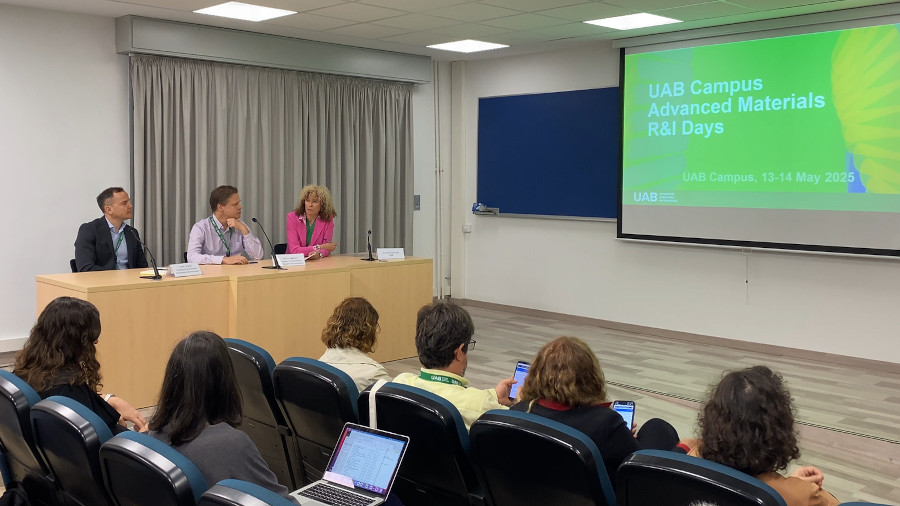The UAB Campus Advanced Materials R&I Days bring together over 50 experts
On 13 and 14 May the UAB played host to the UAB Campus Advanced Materials R&I Days where participants were able to discover the research and innovation potential in advanced materials of the ecosystem of the UAB campus.

On 13 and 14 May the UAB Department of Physics held conferences and seminars for researchers with the goal of presenting the numerous research and innovation possibilities in advanced materials within the UAB campus' ecosystem. Since its creation, the University has participated in the IAM-I Innovative Advanced Materials Initiative, which leads the IAM4EU (Innovative Advanced Materials for Europe) partnership, represented by Xavier Álvarez, head of the Department of Physics.
The inaugural session, presented by the vice-rector for Innovation, Transfer and Entrepreneurship of the UAB, Rosa M. Sebastián, also included the participation of Javier Sanfélix and Wide Hongenhout, Policy Officers of Advanced Materials of the Industrial Transformation Unit of the European Commission (EC) Directorate-General of Research and Innovation, the unit working on the development of the Advanced Materials Act (the future European law on advanced materials). The EC representatives talked on the new policies to achieve a more competitive energy industry while fostering decarbonisation. According to them, "the necessary materials for the industrial development under the European Green Deal and the digital transition" must be achieved, given that there will be more demand of advanced materials for the development of solar panels, batteries, etc. as well as "to reduce dependency on critical energy sources". These policies will be developed following a strategy based on "identifying needs in innovation, accelerating the pace between laboratory and manufacturing, increasing capital and access to funding, and foster the production and use of advanced materials". They explained each point in detail, and announced the creation of a Technological Council in advanced materials, with representatives from member states, "a high-level coordination group".
The session was also attended by Nieves González, member of the Centre for Technological Development and Innovation (CDTI) and national representative of Cluster 4 industry field (Horizon Europe programme), who expressed her gratitude for “having been able to learn about the entire ecosystem of the campus in this area”. Next, the lines that are developed in the field of advanced materials in different departments and research centres of the UAB were presented. Professors Xavier Álvarez and Eva Pellicer from the Department of Physics showed the lines of the department and the PHYNEST project (PHYsics for a greener world: fostering the NExt generation of talented young researchers in novel materials, innovative strategies and energy solutions), to train future leaders in the field of advanced materials, innovative strategies and key solutions to facilitate the transition to a new energy paradigm and promote environmental sustainability.
Lecturer Alba Hernandez, from the Department of Genetics and Microbiology, explained the experience of the PlasticHeal project, developed to provide new methodologies and evidence, through the combination of advanced research and the use of reliable methods, to lay the knowledge base for an adequate risk assessment of nanoplastics and microplastics. On behalf of the Department of Chemistry, lecturers Xavier Sala, Félix Busque, Xavier Geli, Jordi Hernando and Carolina Gimbert presented the research lines of the department related to advanced materials. The day also included the presentation of the activity of the Department of Electronic Engineering in 2DM nanomaterials, CMOS and devices, by lecturers Marc Portí and Xavier Cartoixà. Lecturer Xavier Navarro, from the Institut de Neurociències (INc), presented the lines of research on the application of graphene and nanomaterials in neuroscience, as well as the challenges to achieve the biocompatibility of these materials; and Margarita Navià, head of strategic development of ICN2, presented INNOFAB, a strategic project for the participating entities and for the advanced materials sector. All without leaving aside aspects such as the sustainability of advanced materials, which was addressed by researcher Laura Talens, from the Institute of Environmental Science and Technology of the UAB (ICTA-UAB), and ethical and legal issues, presented by researcher of the Institute of Law and Technology of the UAB (IDT) Anna Capellà Ricart.
Those attending the conference were able to visit the facilities of the Institute of High Energy Physics (IFAE), the Catalan Institute of Nanoscience and Nanotechnology (ICN2), the Institute of Materials Science of Barcelona (ICMAB), the Institute of Microelectronics of Barcelona - National Microelectronics Centre (IMB-CNM-CSIC), and the ALBA synchrotron, where the director of the centre, Caterina Biscari, insisted on the importance “of investing in infrastructure to advance in research”.
The conference ended at the facilities of the Parc de Recerca UAB (PRUAB), where concrete examples of public-private collaboration activities, entrepreneurship and strategies with the surrounding areas that are developed on campus were presented.
With more than 50 participants, the initiative highlighted the contribution of the University from basic research to innovation towards society, an opportunity to learn about and promote the different lines of research and potential among groups, departments and institutes working in the research and innovation hub that makes up the UAB campus, with a very intense and prominent activity in advanced materials.